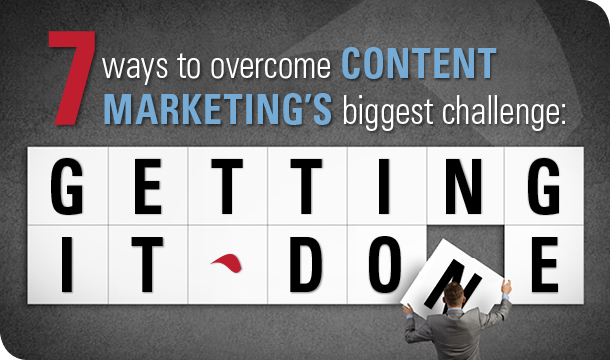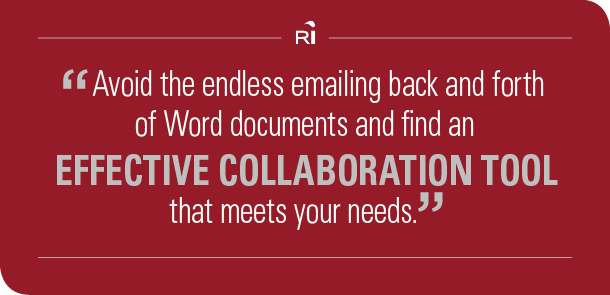7 ways to overcome content marketing’s biggest challenge: just getting it done
We’ve all heard it before:
“I just can’t get my subject-matter experts to give me the information I need.”
“We would do content marketing, but we can never find the time — we’re too busy focused on billable work.”
I get it. Content marketing takes time. It’s the reason I have a viable business, after all.
While simply “getting it done” seems like a low bar to aim for, it is often the most challenging hurdle to success. It’s the same when trying to develop an exercise habit: Getting yourself to the gym can be the hardest part, but you can’t succeed if you don’t show up.

Get Er Done GIF from Larry GIFs
So how do you get your butt out of bed and onto that content marketing treadmill?
1. Create a high-level, simple strategy
And I mean simple. If you’re struggling to get the content machine up and running and spend too much time writing a treatise on your content marketing strategy, you’ll find yourself dead in the water.
I suggest one page, perhaps in table or chart format, covering the following:
-
- Goals — What do you want to achieve with your content?
- Audiences — Who are you targeting with your content? The more narrowly defined, the better.
- Topics — What are you going to create content about? I like to come up with content “buckets,” or major topic categories to focus on.
Share this one-pager with your subject-matter experts (SMEs) every time you work with them to create content. It will help you stay focused and, dare I say, strategic.
2. Create an editorial calendar ‘sketch’
By editorial calendar “sketch” I mean that you shouldn’t feel like you need to map out every single content piece you’re going to create ahead of time. But in general, you should determine:
-
- How frequently you plan to develop content (once a week, every other week, etc.)
- Content types (Are you just going to blog? What about lead generation content, where users have to fill out a form to download it?)
If you’re struggling to figure this out, one way to start is to do monthly themes — focus one month on a “content bucket” and the next on another. And then as timely opportunities arise, you can pivot and mix it up. But the monthly themes will give you structure to start.
3. Don’t leave it up to your SMEs to come up with topics
Your subject-matter experts are not content marketers by trade. They have full-time jobs that don’t necessarily involve content creation. However, they possess the majority of the knowledge and expertise around your products and services. How do you balance this?
Develop a process to work with your SMEs to come up with topic ideas. For example:
-
- Implement an editorial board. This is a group of subject-matter experts who can give you regular insight into your business and industry and keep you up to date on timely trends and issues. Convene your editorial board as frequently as needed (we’ve done it with clients monthly and quarterly) to brainstorm topics and fill out your editorial calendar.
- Hold regular phone calls with SMEs to pick their brains and brainstorm topics.
- Set up Google alerts on topics to stay ahead of issues, trends and changes.
4. Don’t leave the content creation to the SMEs, either
In some industries, having SMEs write blog posts or e-books is unheard of. A software engineer writing a blog post? Ummmm, no.
In other industries, such as the law, it’s the other way around. Ghostwriting is considered taboo by some attorneys.
If you have a SME that (1) has the time to create content, (2) knows how to write (like actually, really write), and (3) understands content marketing strategy, then have at it. If you find this magical unicorn, congratulations. Now go buy a lottery ticket.
At Reputation Ink, we believe great content marketing happens with you pair a SME with a content marketer who understands how to extract the knowledge out of the SME and then translate it effectively into a piece of content. Yes, even lawyer blogs can operate this way.
Our process for developing content includes conducting effective subject-matter-expert interviews, where we skillfully interview the SME, ask the right questions, then write up the content and send it back to the SME for review.
Another way to extract your SMEs’ knowledge — if you don’t want to conduct interviews — is to create template questionnaires that they must fill out.
Whatever way you choose, make sure it is as low-friction as possible. In other words, don’t make it hard to get the information out of your SMEs. You must also earn their trust and prove that you will listen to them, understand the information, and send them back a piece of content that requires little editing.
5. Use collaboration tools
At Rep Ink, we’re big fans of Google’s G-Suite, which allows us to collaborate on pieces of content as a team. We have many clients who use Google’s G-Suite as well, allowing us to easily share creative assets, see edits and comments in real time, and more.
You can also invest in content marketing software like ion interactive, ClearSlide, Scoop.it, Uberflip, Curata, LookBookHQ, Ceros, CoSchedule, Contently and more. And then there’s also Dropbox and Basecamp.
But whatever you do, try to avoid the endless emailing back and forth of Word documents and find an effective collaboration tool that meets your needs.
6. Stay on track with project management software
At Rep Ink, we looooovvvveee Asana. Honestly, implementing this software was one of the best things we ever did. Asana combines to-do lists, deadline-driven project management, and team communication into one. And it’s easy to use.
But you must commit to the software and really use it. We have a dedicated “chaser” (our operations manager) who keeps everyone and everything on track, and is responsible for “chasing” SMEs to schedule interviews, manage approval processes and more.
7. Create a content promotion checklist
We have a content promotion checklist we use for every piece of content we create, which includes:
-
- Email marketing
- Social media (paid and organic)
- Email signatures
- Press releases (to announce big pieces of research, for example)
- Repurposing into other formats, such as video or infographics
- Sales team phone and email scripts
Use the checklist each time you create something to ensure you are getting the most mileage out of your content.
How do you get content done? I’d love to hear your tips. Contact me at michelle@rep-ink.com or on Twitter, @MichelleCKing.











